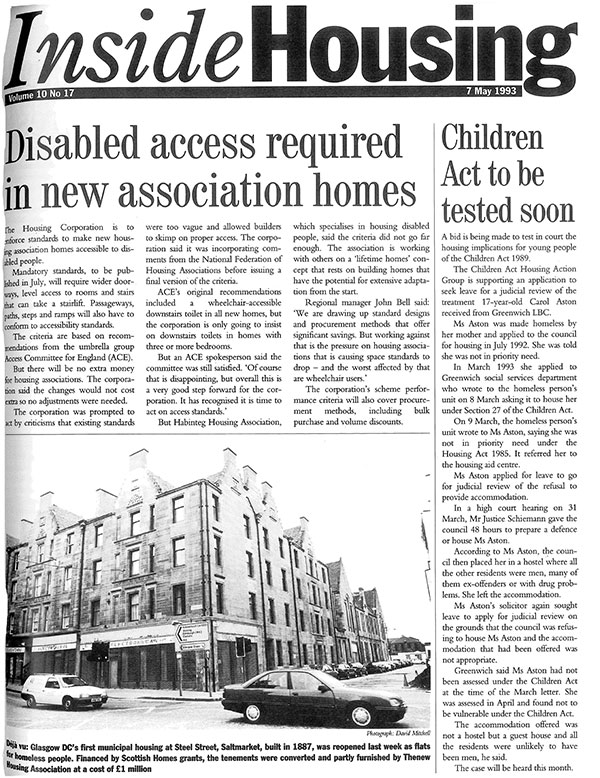You are viewing 1 of your 1 free articles
From the archive: new disabled access rules for association homes
Inside Housing looks back at what was happening in the sector this week five, 15 and 25 years ago
25 years ago
New homes should be built by housing associations to be accessible to disabled people, Inside Housing reported as its front page story.
Doorways should be wider, access to rooms should be level, and passageways, steps and ramps should all conform to mandatory accessibility standards, based on a set of recommendations by a group called Access Committee for England, or ACE.
However, housing associations would get no extra money to implement the mandatory standards being set by the regulator, the Housing Corporation.
Habinteg, which still specialises in housing for disabled people, said the standards did not go far enough. It was already working on its Lifetime Homes standard, which would allow homes to be adapted over time as residents’ needs changed.
15 years ago
A government target of building 200,000 homes in the South East was unlikely to make a dent in unaffordable house prices in the region, a committee of MPs had warned.
The select committee for the then-Office of the Deputy Prime Minister had carried out a six-month investigation into the proposal, known as the Communities Plan, and its conclusions were rather negative.
“The government’s objective to bring down house prices is unlikely to be achieved,” the MPs concluded. “There is ample evidence that even the enlarged housebuilding programme in the South East will have little impact on house prices. This underlines the importance of the new developments including amounts of affordable housing.”
The building programme would cost £20bn, the MPs added, much more than the £610m allocated. “It is questionable whether the benefits will justify such a huge outlay,” the report warned.
Merron Simpson, policy officer at the Chartered Institute of Housing, agreed: “We are not convinced that this will work either for the South East or the rest of the country.”
Five years ago
A housing association in Birmingham had a new plan to fill 10% of job vacancies with its own tenants.
Family Housing Association, which had 2,500 homes and has subsequently become part of WM Housing (see office, above), had at that time only one tenant working for it, a situation it wanted to change.
Asha Sendawula became a resident involvement assistant in 2007 when she was also renting a two-bedroom terrace from the association. At the time of the interview, she had become a project co-ordinator.
Family was breaking new ground in the sector by setting itself a target on employing tenants.
Whatever the job, tenants would hear about it first, and as long as they met minimum requirements, they would be guaranteed an interview.










